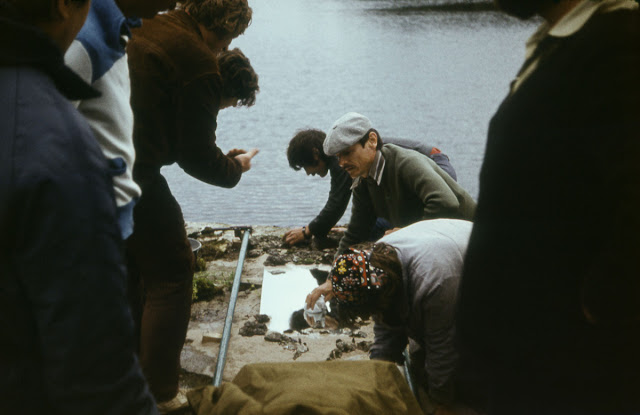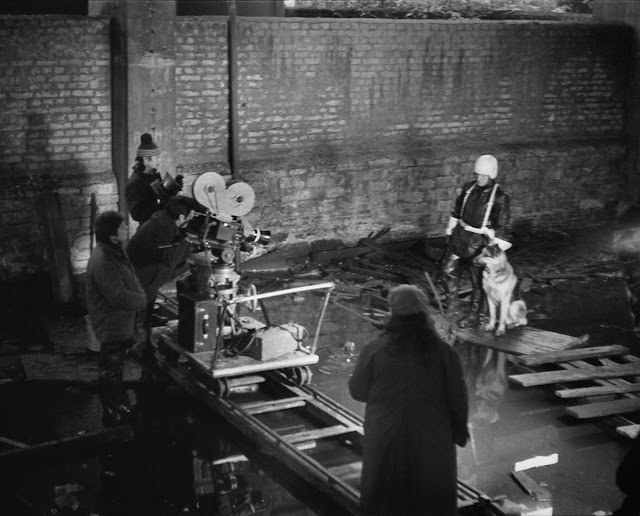Stalker is a 1979 Soviet science fiction film directed by Andrei Tarkovsky with a screenplay written by Arkady and Boris Strugatsky, loosely based on their 1972 novel Roadside Picnic. The film tells the story of an expedition led by a figure known as the “Stalker” (Alexander Kaidanovsky), who guides his two clients—a melancholic writer (Anatoly Solonitsyn) and a professor (Nikolai Grinko)—through a hazardous wasteland to a mysterious restricted site known simply as the “Zone,” where there supposedly exists a room which grants a person’s innermost desires. The film combines elements of science fiction and fantasy with dramatic philosophical, and psychological themes.
Director Tarkovsky spent about a year shooting all of the exterior scenes. The first part of this shoot was done over the spring and summer of 1977 with cinematographer Georgi Rerberg, using a new Kodak 5247 film stock provided by movie producer Sergio Gambarov. However, after developing these negatives, they came back with an unwatchable shade of dark green. According to the film’s sound technician Vladimir Sharun, Tarkovsky always claimed that the movie was sabotaged by one of his enemies, a “well-known Soviet film director”: the Kodak 5247 stock was reportedly stolen, and ended up in the hands of this director, while Tarkovsky unknowingly got a regular Kodak stock in return that was then developed incorrectly. Sharun, however, attributed the problem on “the usual Russian sloppiness,” as the Kodak 5247 was newer to Soviet laboratories at the time, who didn’t know how to properly process it. The disaster proved to be the final straw for Rerberg, who got the blame for the incident and walked off (or was released from) the film, so Tarkovsky had to shoot most of the film again with a new cinematographer, Aleksandr Knyazhinskiy. This contributed to the film’s two-part narrative structure. Allegedly, the newly shot footage strayed even farther away from the source novel Roadside Picnic, and had a different look. Asked about this, director Tarkovsky said “no mother gives birth to the same child twice.”
The central part of the film, in which the characters travel within the Zone, was shot in a few days at two deserted hydro power plants on the Jägala river near Tallinn, Estonia. The shot before they enter the Zone is an old Flora chemical factory in the center of Tallinn, next to the old Rotermann salt storage (now Museum of Estonian Architecture), and the former Tallinn Power Plant, now Tallinn Creative Hub, where a memorial plate of the film was set up in 2008. Some shots within the Zone were filmed in Maardu, next to the Iru Power Plant, while the shot with the gates to the Zone was filmed in Lasnamäe, next to Punane Street behind the Idakeskus. Other shots were filmed near the Tallinn–Narva highway bridge on the Pirita river. A small set was built in Moscow not far from the CHPP-20 thermal power plant for the scene exiting the bar.
Several people involved in the film production, and possibly Tarkovsky himself, died from causes that some crew members attributed to the film's long shooting schedule in toxic locations. Vladimir Sharun recalled:
“We were shooting near Tallinn in the area around the small river Jägala with a half-functioning hydroelectric station. Up the river was a chemical plant and it poured out poisonous liquids downstream. There is even this shot in Stalker: snow falling in the summer and white foam floating down the river. In fact it was some horrible poison. Many women in our crew got allergic reactions on their faces. Tarkovsky died from cancer of the right bronchial tube. And Tolya Solonitsyn too. That it was all connected to the location shooting for Stalker became clear to me when Larisa Tarkovskaya died from the same illness in Paris.”
Stalker was released by Goskino in May 1979. Upon release, the film garnered praise in the Soviet and Warsaw Pact press, but only mixed reviews in the West, but in subsequent years it has been recognized as one of the greatest films of all time, with the British Film Institute ranking it #29 on its 2012 list of the “100 Greatest Films of All Time.” The film sold over 4 million tickets, mostly in the Soviet Union, against a budget of 1 million roubles.






































0 comments:
Post a Comment